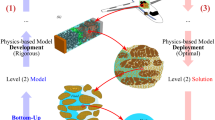Abstract
While there have been considerable efforts over the past 30 years to improve productivity in scientific computation through the creation of subroutine libraries, much of the mundane, error-prone work in developing simulation codes has remained. This situation has spurred the development of specialized efforts in both the numerical and symbolic computation domains. For instance, numerical software like PDECOL, L1SODE, and UNPACK will solve large classes of partial differential equations, ordinary differential equations, and linear equations, respectively. On the symbolic side of this issue, a few basic tools for developing simulation codes were created by Wirth in the late 1970s. We introduce more advanced uses of symbolic techniques, including two strategies that link the symbolic and numeric computing approaches in the context of simulation codes.
Similar content being viewed by others
References
Brown, S. A. (1989).panacea Users Manual, M-276, Lawrence Livermore National Laboratory.
Cook, G. O., Jr. (1982). Development of a Magnetohydrodynamic Code for Axisymmetric, High-β Plasmas with Complex Magnetic Fields, Ph.D. thesis, UCRL-53324, Lawrence Livermore National Laboratory, December 1982.
Cook, G. O., Jr. (1990).Int. J. Mod. Phys. C 1, 1–51.
Dubois, P. F. (1989). The Basis System, M-225, Lawrence Livermore National Laboratory.
Engquist, B., and Smedsaas, T. (1980).SIAM J. Sci. Stat. Comput. 1, 249–259.
Finan, C. H., III (1980). The Alternating-Direction Implicit Numerical Solution of the Time-Dependent, Three-Dimensional, Single Fluid, Resistive Magnetohydrodynamic Equations, Ph.D. thesis, UCRL-53086, Lawrence Livermore National Laboratory.
Gates, B. L. (1985).SIGSAM Bull. 19, 24–42.
The GIBBS Group (1984). GIBBS—A Programming Environment and Workstation for Scientists, CTSSE 84-7, Cornell University Center for Theory and Simulation in Science and Engineering.
Hilfinger, P. N., and Colella, P. (1988). FIDIL: A Language for Scientific Programming, UCRL-98057, Lawrence Livermore National Laboratory.
Kant, E., Daube, F., MacGregor, W., and Wald, J. (1990). Synthesis of Mathematical Modeling Programs, TR-90-6, Schlumberger Laboratory for Computer Science.
Rice, J. R. (1987). ELLPACK: An Evolving Problem Solving Environment, inProblem Solving Environments for Scientific Computing, B. Ford and F. Chatelin (eds.), North-Holland, Amsterdam, pp. 233–241.
Ruppelt, T., and Wirtz, G. (1989).Parallel Comput. 10, 15–28.
Sewell, G. (1985).Analysis of a Finite Element Method, Springer-Verlag, New York.
Tan, H. Q. (1986). Automatic Formula Derivation forFortran Code Generation in Finite-Element Analysis, Ph.D. dissertation, Kent State University.
Thornburg, J. (1989). A PDE compiler for full-metric numerical relativity, inFrontiers in Numerical Relativity, Cambridge University Press, Cambridge, p. 370.
Umetani, Y., Tsuji, M., Iwasawa, K., and Hirayama, H. (1987).Deqsol, A numerical simulation language for vector/parallel processors, inProblem Solving Environments for Scientific Computing, B. Ford and F. Chatelin (eds.), North-Holland, Amsterdam, pp. 147–162.
Wirth, M. C. (1980). On the Automation of Computational Physics, Ph.D. thesis, UCRL-52996, Lawrence Livermore National Laboratory.
Author information
Authors and Affiliations
Rights and permissions
About this article
Cite this article
Cook, G.O., Painter, J.F. & Brown, S.A. How symbolic computation boosts productivity in the simulation of partial differential equations. J Sci Comput 6, 193–209 (1991). https://doi.org/10.1007/BF01062119
Received:
Issue Date:
DOI: https://doi.org/10.1007/BF01062119




